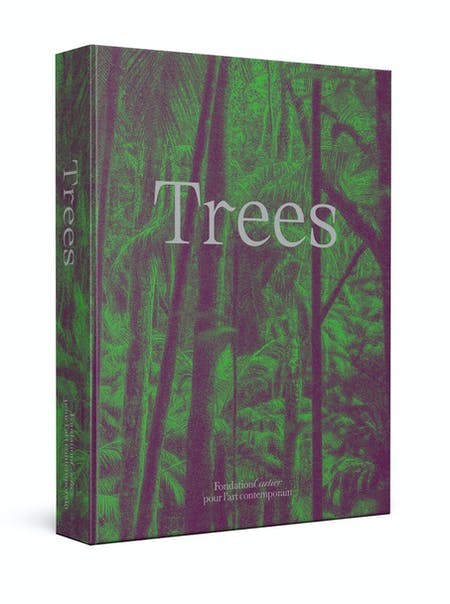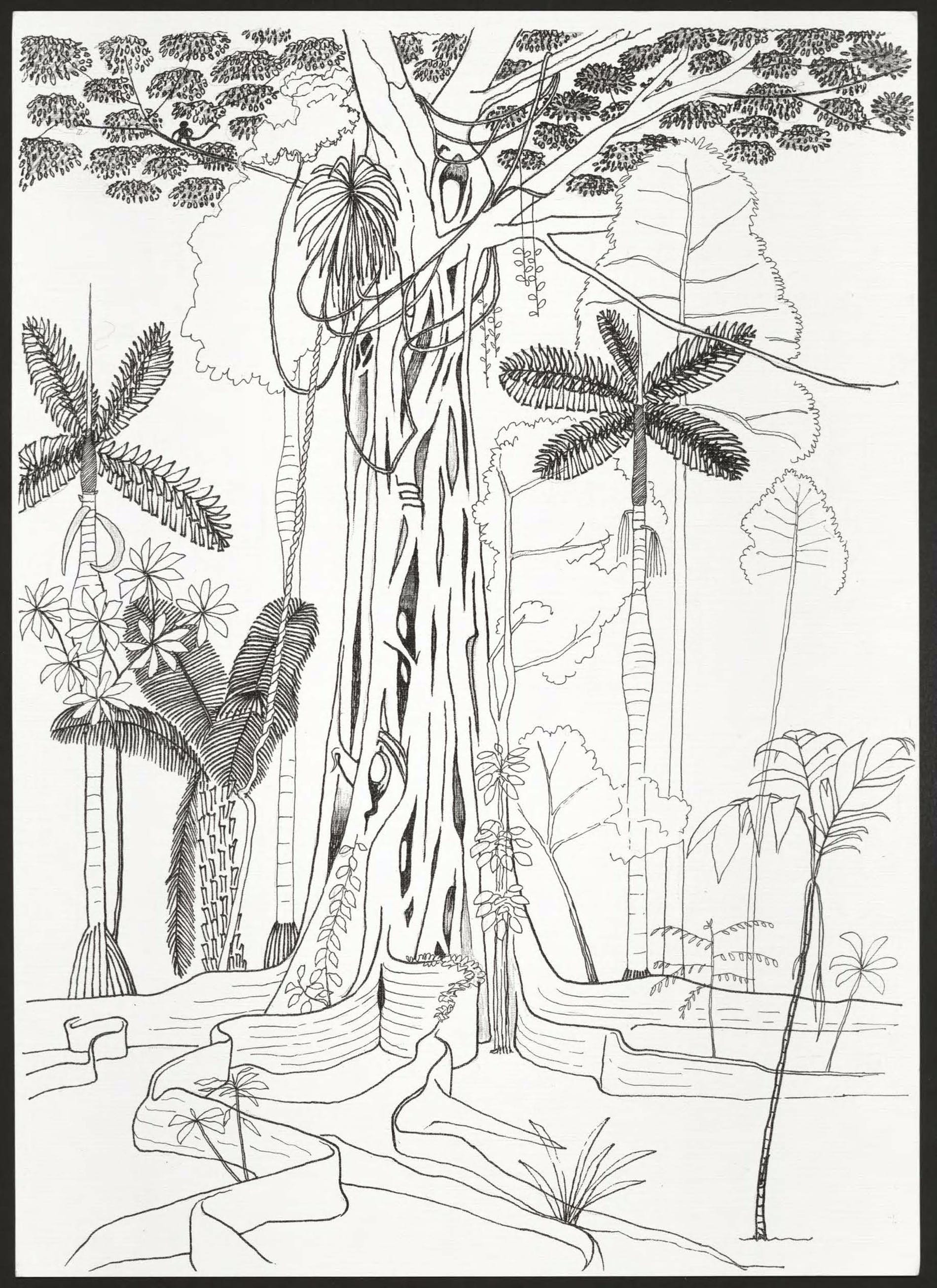Francis Hallé - A Life Drawing Trees - Interview with Emauele Coccia

A lover of trees and plants, specialist in tropical forests, and a fervent defender
of primary forests, Francis Hallé is a privileged witness of the incredible wealth of nature, as well as its fragility in the face of human activity. For about sixty years, this traveling botanist has spent his life surrounded by trees. While he studies them scientifically, he also looks at these living beings with a perpetual sense of wonder. Between contemplation and methodical rigor, he draws the flowers, foliage, and architecture of trees in the notebooks that have accompanied him since the beginning, his own unique way of truly and profoundly knowing them.
Emanuele Coccia: Francis, you have traveled all over the world, spending time in tropical forests, observing and drawing thousands of trees in your notebooks. I can’t even begin to imagine the number of species and trees you must have stored in your memory. However, I am curious : What is your first memory of a tree?
I was four years old and France was occupied by Germany. My family couldn’t stay in Paris. We moved 40 kilometers out of the capital, seeking refuge on a hectare of forest and garden. There were nine of us: my parents, and my brothers and sisters. Thanks to this small plot of land, we not only lived very well during the war, but we were also able to help our neighbors. I remember thinking that it was possible to meet all our needs with just a piece of forest and a small vegetable patch. I especially remember a chestnut tree, not a very big one, I used to climb. After reaching the top of one tree, you could easily climb a big Corsican pine tree at least forty meters high. For me, trees were akin to easy, welcoming roads. They provided an entire landscape and a way of seeing the world from above. All the work I did later on canopies is linked to my childhood memories.
Was this when you decided to devote your life to trees?
That happened long after. When I entered the Sorbonne in Paris, I was not really interested in plants, but rather animals, indeed like 99 percent of students, by the way. Today, I like animals, but I can’t take them seriously because they move all the time. I’ll even go a step further: I’m an animal myself, and if you show me one, even if I don’t know what species it is, I can already identify a lot of things about it. I’m not a zoologist, but I know how it moves, I can recognize the front and the back, the paws, the rear, I know it has two identical profiles, right and left. I also know that if I give it food it will be happy, and if I clap my hands it will be frightened and run away. As a student, I lived not far from the boulevard Raspail. On my balcony, a small plant had grown, although I didn’t take care of it. I didn’t know what it was, I didn’t even know that such a thing could have a name. The plant survived thanks to the Parisian rain. I watched it grow over the course of a year, produce beautiful flowers, with a pure and rigorous aesthetic, give seeds and reproduce. The following year, the same plant was growing in all of the pots. It was magical ! At that time, I thought that a tree necessarily had to have leaves. I learned in my studies that some species don’t. In the tropics, many trees have no leaves and yet they are still alive. This is when I realized that plants were much more interesting than animals. I didn’t know anything about them, and I had everything to discover.
Can we say that with trees, you experienced a kind of wonder, an aesthetic encounter that animals were unable to evoke?
Absolutely. For me, trees are much more beautiful than animals. Animals are dirty, noisy, and when they die, they smell awful. When a tree dies, it doesn’t smell bad because its molecules contain less sulfur. I wonder if our initial relationship to trees is aesthetic rather than scientific. When we come across a beautiful tree, it is an extraordinary thing.
Is it because you find them so extraordinary that you felt the desire to draw trees?
My maternal grandfather always sketched trees, but only for his own aesthetic pleasure. He was Parisian, like me, but worked in Brittany. He spent his life drawing, painting, and engraving scenes from this region. I have spent my life drawing trees, but with a slightly different purpose, although there is a clear connection. I loved my grandfather. For me, drawing is a normal way of representing things.
Essentially botanists have always needed an aesthetic intermediary.
Botanists have always drawn. I’ve seen some magnificent collections of old plant drawings at the University of Padua! It seems to me that entomologists also drew, even though they use photography today. The photographic medium cannot be applied to botany because it can’t separate the plant from its environment. Another much more important reason is that trees are extremely complex, immense structures. Photographing in 1/50th of a second is not adequate if you truly want to get to know a tree. I work deep in the forest and sometimes I need a whole morning to draw a tree. I move around it, I look at it from the front, from the side, from below, from above. All angles are good. Questions come to my mind and the answers appear before my eyes. It takes time to become familiar with a tree, and photography is much too rapid a medium. When I draw a tree, when I record the external forms of plants, I feel like I belong, that I’m really doing what I’m supposed to do here on Earth. I forget about time.
Do you lose track of time because you draw the trees in detail ? Do you sketch before you draw?
In the field, I make pencil sketches in my notebooks and take notes. At the start of my career, I used small notebooks that I found in the countries I visited, bought in school supply stores, on street corners, but these were very fragile. Nowadays, with experience, I prefer to use thick white paper in large notebooks that close with a magnetic clasp. When I return to my camp or when I’m in a laboratory at a table, I put my sketches and notes together. I do some drawings in marker or pen. I never color them in while I’m in the field ; it’s almost impossible. I add color when I get back home. Doing a watercolor while you are in a tropical forest, under the rain, is not very practical. I can do it but I need the right conditions. Originally, all of these drawings were somewhat random, but over the years I was able to categorize them in folders by plant family. To be able to compile all the Asteraceae, Apocynaceae, Violaceae, and so on that I had drawn all around the world was very interesting.
Your notebooks, which are absolutely sublime, resemble the notebooks that anthropologists used as tools in the nineteenth and twentieth centuries. But yours bear witness to the plant kingdom. You consider plants to be on the same level as humans. This is remarkable.
I do have one regret : that I’m solely considered a botanist. I wouldn’t call myself an ethnographer, nor do I consider myself an artist. But when I travel, I am as interested in the countries I visit as the plants that grow there. Tropical countries fascinate me. These are the least known and most interesting regions on the planet. The notion of time, for example, is different between the tropics and Europe. Time doesn’t have the same meaning. I am European, I live with the past, the present, and the future, and this seems so obvious to me that I have difficulty understanding that my African or Asian interlocutor does not have the same temporal references as I do. For them, everything is circular. Things and events recur regularly. Once we understand this, the dialogue changes completely.
Indonesia, Gabon, the Galapagos Islands, Malaysia, Tasmania, Thailand... You have traveled all over the world observing and drawing trees. What has your greatest encounter been? How do you choose what trees to draw?
You appreciate different trees depending where you are : Africa, America, or Asia. In Africa, I love the moabi. In America, the rubber tree. In Asia, the durian. I still haven’t found a favorite tree in Europe yet. I mainly focus on drawing the tree’s architectural structure. When I’m in the forest, I always begin with an ideal tree ; one that is neither too young nor too big, but which reveals as much of its architecture as possible. In the rainforest, this process is quite easy because there are plenty of young trees. You quickly realize that the shape of a tree, even when young, is never random. Each species has its own “architectural model,” that is, a tree’s growth and development follow a genetic program that relies on three principles. First, the distribution of branches on the trunk, which can be continuous, rhythmic—in other words, a new level is added each year—or irregular. It can also be nonexistent, as many trees have no branches, such as palms. Second, the orientation of the branches, which can be vertical, oblique, or horizontal. Third, the position of the flowers. These can be terminal—the carrier axis terminates in the flower head—or lateral, which means that nothing prevents the main support from growing ; in other words, it has the possibility of infinite growth. It’s extremely simple. With these three principles, you have the basis of an infinite combinatorics. The very high number of possible combinations is probably too large since the architecture of the trees that we know today—approximately 100,000 species— makes use of only twenty-four models. Whatever tree you look at will display one of these architectural structures. The challenge would be to find a plant that does not conform to one of these patterns!
In the 1970s, when you became interested in the architectural analysis of trees, very little existed on the subject. Where did you get the idea to study it?
When I finished my studies, I was a Linnean botanist (1). In order to identifya plant, I needed to see its flowers and fruit. Without these two characteristics, I couldn’t do anything. When I arrived in Côte d’Ivoire in 1966, there were some magnificent primary forests, but no flowers or fruit to observe. When there were some, the flowers were 60 meters from the ground thus inaccessible, and the fruit that fell from the trees were rotten and damaged by their fall and impossible to identify. It was incredible. One day, I met the chief of a Baule village and I asked him: “Chief, what’s the name of that large tree over there?” “That’s a framir (2).” “Chief, how do you know that? Have you seen its flowers?” He began to laugh. “Framir. flowers? They don’t concern me. I don’t even know if a framir. has flowers.” The chief was a remarkable botanist but certainly not a Linnean one because he didn’t need the flowers or fruit to be able to identify the tree. He continued : “Look. This tree is a framir., that one is a dabema, and the other one over there, an essia. You can easily see that they’re not the same.” So what was the difference between them? The architecture. That day I experienced a true intellectual and scientific epiphany. You could be a botanist without being a Linnean. It was from that moment that I could speak about the evolution of plant families. There are tropical arboreal ancestors whose most evolved, refined, and sophisticated descendants exist in high latitudes in the form of grasses. In 90 percent of plant families, you find this evolution.
This elasticity, specific to the plant world, does not exist in the animal kingdom. I have often wondered why this architectural model, elastic in the sense of it being “structural,” has remained invisible for centuries, whether to Carl Linnaeus or to other naturalists and botanists.
I don’t know why it wasn’t studied in Linnaeus’s day. But with regard to our era, I have the feeling that what is scientific is expected to be very complex. The more complicated the subject, the more intellectually legitimate it is considered. I have been told that what I do is not serious, that I work with the naked eye and that the same work could have been done in the seventeenth century. It’s true ! It’s not difficult : my material comes down to a pencil and a sheet of paper, and I use these to draw architectures. All of this is much too simple for current science to be interested in. That said, observing the architecture of trees has led me to reflect on complex genetic issues.
Indeed, and by observing trees, you have also added to our knowledge of the phenomenon of reiteration.
Jean-Henri Fabre had already observed and studied the process of reiteration. He was the author of Leçons à mon fils sur la botanique (3), in which he explains that trees are colonists. Darwin noticed this too. Then everything was forgotten. Today, we know that the architecture of a large old tree often implies the process of reiteration. Admitting that a young tree can grow on an old tree is quite a disturbing idea! When we talk about reiteration, we’re not talking about a seed that sprouts, but a bud that wakes up : it produces a leafy stem whose roots take anchor under the bark and reach the ground very quickly. Then, growth repeats the architectural model of the species and the carrier tree becomes a colony. Our ancestors had understood the parasitic nature of the shoot, hence the names given in various European languages: “gourmand” in French, “sucker” in English, “succhione” in Italian, and “chupón” in Spanish. With reiteration, we can distinguish two kinds of trees: “unitary” and “clonal.” Unitary trees are not reiterative. This means that their growth is limited to that of their architectural model. They have a simple shape and an attractive aesthetic—they are often used for decorative purposes. As for clonal trees, they reiterate in abundance. They are more modern, less beautiful than unitaries, but above all, they live much longer. In Tasmania, there is a very famous shrub known as Lomatia tasmanica. It is 43,000 years old—at the time it first appeared there were two human species: Homo sapiens and Neanderthals—and it happened to be a clone 3 kilometers in length. Not only is this shrub still alive, but it is not old at all. If we leave it alone, it will continue to live and reproduce; there is no reason for it to die. It’s fascinating! Is this an example of an immortal tree capable of withstanding even climate change? This question has yet to be answered but it leads us to completely renew our vision of life.

What is wonderful is that you have shown us something that is both fundamental and beautiful. Botany can and should provide us with a completely different vision of life, especially when biology continues to focus on animals.
In reality, biology is almost totally centered on human beings. For many zoologists, animals make it possible to understand and to experiment with things when this is impossible to do with humans. The idea that animals can allow an understanding of human beings is old, it goes back to Greek antiquity and Aristotle. With plants, I am protected from this digression. The plant represents an absolute alterity with regard to humans. Moreover, it doesn’t move and doesn’t make any noise. It is therefore naturally considered a life form without much interest.
It’s true to say that people sometimes display a kind of negligence when it comes to plants. There’s a kind of fear, I would even go so far as to call it a hatred, for these living beings to whom we deny the possibility of life.
The fear is related to the forest, not the plants. This feeling is very old, it goes back to Roman civilization. For the Romans, the forest was the place of the “stranger:” it was in the forest that the barbarians hid. Moreover, the French word “forêt” [forest] comes from the Latin foris, which means “outside.” In English, the word “foreign” refers to what you don’t know, that which is far away. It may be due to the ecological legacy of antiquity that the tree continues to be considered a material for trade, which is not very commendable. We have remained within this fear of the forest and the desire to sell wood.
However, your work has fostered a growing intellectual awareness. Otherness is now something that is acknowledged, accepted.
This is partly true. But it hasn’t affected loggers. By the time the message reaches them, there will be no more forests left. It is terrible to witness their destruction. If my contemporaries could see the primary forests in Tasmania, they would be at a loss for words ! They are located in the other hemisphere, but at the same latitude as here in Europe. Not far from us, in Poland, the primary forest of Białowieza is also in danger. When I became aware of this threat, I felt that the time had come to react by promoting the renaissance of a primary forest in Western Europe, extending over several countries. This is one of my next projects. We would be able to enter the forest, but only via the canopy, so as not to damage the trees. For the moment, nothing has been officially launched, but I think things will happen quickly. There is a subversive dimension to realizing this project because in our current society, things need to go very quickly. But this adventure is a bet over a thousand years, a bet on intergenerational collaboration.
You frequently emphasize the temporal dimension. Trees are one of those living creatures that have the ability to live for a very long time.
Yes, and for much longer than us. Here in Montpellier, an article in Midi Libre, our local newspaper, suggesting admiring a hundred-year old olive tree. But this is ridiculous. An olive tree aged one hundred years is the equivalent of a little schoolboy in short pants! It’s from two thousand years plus that things become interesting.
How do you explain the longevity of trees?
There is a short- and a long-term answer. A team of scientists at the University of Oviedo in northern Spain has shown that, in humans, DNA methylation occurs over the course of a lifetime, while it occurs annually in trees4. The bud that opens in the spring is totally juvenile. All the genes are unmethylated, then they gradually methylate during the summer. There are demethylases the following spring and the process starts over again. The first response to this is that the tree remains young. But this is only true over a few hundred years. The second response, which explains why certain trees can live for thousands of years, is that they are capable of vegetative propagation, which humans are strictly incapable of! The original tree generates suckers at its base or roots, or else falls and provides shoots. It has thirty-six possibilities for vegetative propagation that have no time limit. Today it is believed that some hundred trees are concerned by this immortality.
A tree can live for a long time but its survival is often threatened by its environment.
The life of a plant is not easy because it is edible and cannot move. To escape death, a first solution is simply to be much bigger than its predator. In fact, trees are large as this is their way of not disappearing. Animals can eat part of the tree, even a large part, but the tree will continue to grow. It is the tree’s unlimited growth that allows such dimensions. This is a form of adaptation in response to the threat from predators.
Despite their impressive size, men and women do not consider trees and plants in the same way as they do animals. This is rather amazing and it starts very early. In children’s books, for example, animals always have an identity: there is a lion, a panther, and so on; but the plants are only green spots. They are never something specific.
That’s true. We see the animals but we are insensitive to the trees. This comparison between plants and animals has always been something extraordinarily fruitful for me. There is a limitless number of differences between plants and animals in all areas. When animals eat, energy enters their body through their internal surfaces, the digestive surface. The opposite is true for plants: energy enters via the external surface. Looking at the outer surface of the plant teaches us almost everything you need to know about it. There is no inner environment. It’s not hollow. We, as animals, are all hollow. We are volumes while they are surfaces. In order to survive, we poor animals are forced to run after our food. Plants find food by exposing themselves to the sun, with their feet in moist ground. Plant excrement is the lignin molecule that keeps the vessels open. In general, animals are not interested in their excrement. Moreover, this is evacuated via the rear of the body and animals then move away from it because they have no use for it. Plants, on the other hand, retain their excrement and use it throughout their lives. Another opposition: plants are much more mobile than animals. If a dangerous animal escapes from a zoo, it is killed within forty-eight hours. If a seed flies out of a botanical garden and lands on a cliff 10 kilometers away, nothing happens. Fifty years later, a clever botanist might find that this bizarre plant reminds him of Venezuela and wonders what it’s doing in that particular spot. As this is not an immediate danger, there is no reason to even report it to the authorities. The plant will multiply and so the cliff s along the Côte d’Azur or the Italian Riviera become covered with plants native to Venezuela. People aren’t even aware of this. Trees have a freedom that animals don’t have. They have complete anonymity.
What formidable luck!
We have often scorned the vegetal solution, we still hold it in contempt, but in reality it is much better. If we don’t change our outlook on global ecology, our societies will go from bad to worse. This change is still utopian for the moment, but we really need it, otherwise our world will not exist for very long. This is painful for the human being because it implies a fall from our pedestal. I think that since Copernicus, Darwin, and now the movement in favor of plants, the human race has gone down a notch each time. It has lost its central position. One day, a friend asked me, “If human beings disappeared, who would it bother, besides us?” I found the question a bit harsh, but true.
Montpellier, January 2019
1. Swedish naturalist, Carl Linnaeus (1707–1778) was the author of a general classification of natural beings (plants, animals, and minerals) according to a binomial system. He is one of the founding fathers of modern botany.
2. Also known as an Ivory Coast almond.—Ed.
3. Jean-Henri Fabre, La Plante. Leçons à mon fils sur la botanique (Paris : Delagrave, 1876).
4. Substitution, in a molecule, of a methyl radical for a hydrogen atom.

The Fondation Cartier has published a catalog allowing readers to discover all of the works presented in the exhibition through almost 500 images, as well as a rich ensemble of scientific and critical texts. Combining the work of painters, photographers, architects, sculptors, philosophers, botanists, and climatology specialists, this publication highlights the beauty, ingenuity and biological wealth of trees, plunging the reader into the fascinating world of these heroes of the living world.
Foreword by Bruce Albert, Hervé Chandès, and Isabelle Gaudefroy, exhibition curators
Édition Fondation Cartier pour l’art contemporain, Paris
French and English versions, Price: €49
Distribution: Thames & Hudson
related posts

.jpg)
Art & Culture
'NOTATIONS ON TIME' AT ISHARA ART FOUNDATION
.gif)






